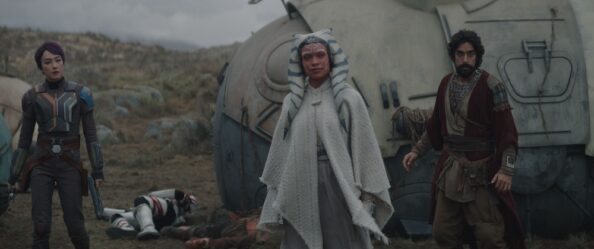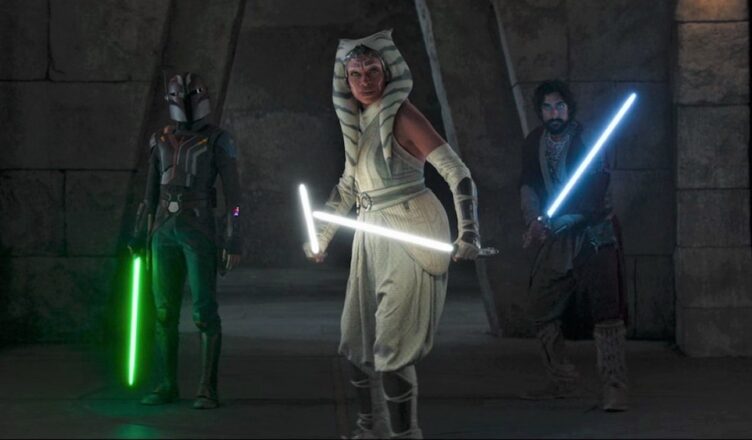The Ahsoka series on Disney+ drew complaints from fans about how the characterization of Ahsoka Tano is different from what audiences saw in her previous depictions. In her debut in The Clone Wars, the character was more optimistic and light-hearted. Or irritating and obnoxious, depending on who you ask. In the animated Star Wars: Rebels, she was more focused and fighting to save the galaxy from the Empire. However, in the Ahsoka series, the character seems bitter and sour, and almost, grumpy. But Ahsoka episode 7 proves that this is part of her character arc, and an incredibly well-done one at that.
Please note that the following will contain spoilers for all episodes of Ahsoka, now streaming on Disney+.
A Different Ahsoka In Her Clone Wars Days
Before we dive into Ahsoka’s brilliant arc as evidenced in Ahsoka episode 7, let’s take a look back into why her character changed. In her debut, she was but a child Padawan assigned a new master in Anakin Skywalker in The Clone Wars. Throughout that series, the headstrong and eager young Tano learned at the hands of Skywalker. She learned to be unpredictable, as Admiral Thrawn (Lars Mikkelsen) describes in Ahsoka episode 7. But she also learned to improvise, take things in stride, and not to mention, see the bigger picture. Ahsoka was such a light-hearted character, and mature for her age, that she was also known for making quips and being snippy with others. Garnering her the nickname of ‘Snips’ from her Master.
As Clone Wars went on, this characterization remained largely the same. Until the end where Ahsoka was wrongly accused of a crime, only for the culprit to be someone else. But during this experience, she learned of the rigidity and blindness of the Jedi order. How easily they stopped supporting her, despite her innocence. So Ahsoka left the Jedi Order and ended her training and association with Anakin Skywalker.
Ahsoka Was A Leader In Rebels
When we see Ahsoka again in Star Wars: Rebels, she is now a Rebel, fighting against the Empire of her own accord. Not as a Jedi, but as a soldier. This Ahsoka has lived through Order 66. She has survived the eradication of the Jedi Order and the betrayal of the Emperor on the entire galaxy. She has lost those closest to her, thrusting her to join the Rebellion and fight against the Emperor. As code name Fulcrum, she aided the rebellion in whatever manner she could.
It was during Rebels, however, that Ahsoka first learned that her former Master became the dreaded Darth Vader. In an epic showdown, she took on Vader for the first time. After a brief side adventure with Ezra Bridger in the World Between Worlds, Ahsoka returned to end her battle with Vader. However, we never learned how Ashoka felt after coming face to face with her former Master, now turned Sith Lord. That is until Ahsoka episode 7.
Why Ahsoka In Episode 7 Changed From Her Animated Appearances
When we begin the Ahsoka series, the character is admittedly muted, sullen and seemingly embittered. We learn of a history with Sabine Wren (Natasha Liu Bordizzo) that didn’t end well. We learn of her unwavering obsession to find Thrawn and prevent a war with the Imperial Remnants. But she’s not the Ahsoka we knew. She was focused, cold and even cruel to a certain degree. But as the series progressed, things became clearer.
Ahsoka held on to the guilt of walking away from Anakin Skywalker. She must have felt partially responsible for his turn to the Dark Side. If she had been by his side, maybe she could have prevented his fall. Her training with Sabine also ended abruptly, as we learned in the Ahsoka finale, that she was afraid Sabine was training to be a Jedi for the wrong reasons. I’m sure she feared the loss of her family might turn her to the Dark Side, exactly how Anakin’s attachment to his mother and to Padme, allowed Palpatine to manipulate him.
Ahsoka had difficulty reconciling her training, given during wartime, and her place in the world now, during peace, with the threat of a new war looming. All of this comes to a head when she’s in the World Between Worlds again, facing a representation of Anakin Skywalker (Hayden Christensen). All her issues are laid bare as she, symbolically, completes her training with Anakin. As she chooses the path of light and embraces her own path separate from her Master’s. She finds closure in her love for Anakin and her struggle with who he became in Vader. She’s able to separate who Anakin was, from who he became.
Ahsoka Mirrors An Obi-Wan Moment
Similar to how the last fight between Darth Vader and Obi-Wan Kenobi in that series resulted in Kenobi walking away from Vader. Reconciling that Vader is now Anakin, as he bids farewell to his friend, is similar to what’s going on in Ahsoka. After her meeting with Anakin, Ahsoka embraces her former Master, while separating him from who he became, and his actions as Darth Vader.
Ahsoka episode 7 sees her training using Anakin’s recorded holograms, finally proving that she is no longer conflicted about her love of Anakin. She was able to separate the two versions of Anakin, accepting her legacy, as he told her in Ahsoka episode 5. And all of this is evident in the change to her character in Ahsoka episode 7 and ultimately, the Ahsoka finale.
The New Ahsoka Is In Line With Her Animated Appearances

Right after her return from the World Between Worlds, Ahsoka is immediately lighter, more upbeat and, dare I say, cheerful. She seems less burdened and more relaxed. As she plans to communicate with the Purgill and embark on a new adventure into the unknown depth of a different galaxy, she is unusually aloof about it all. Much to Huyang’s (Devid Tennant) dismay. Her plan seems reckless and impulsive, and she seems completely fine with that. It’s the same unpredictable and eager Ahsoka we’ve seen before, years ago.
Even in Ahsoka episode 7, she is smiling, laughing and making jokes and quips as she used to before. It’s the most cheerful version of the character we’ve seen in live-action thus far. Even her interactions with Sabine and Ezra near the end were upbeat, uplifting and very much positive. As a character, she seemed happier than she’s been in the entire series.
Ahsoka Episode 7 Should Teach Audiences To Let The Storyteller Finish The Story
This arc of the titular character of a Disney+ series should be a lesson for fans who are quick to criticize every unexplained and incomplete story arc of characterization without the story being complete. While the Ahsoka at the beginning of the series was drastically different, it was all part of an arc that sought to return Ahsoka to who she truly is, after resolving the internal struggle of the character. It’s the perfect example that while episodic storytelling is definitely a skill in and of itself, certain stories make more sense when the entire story finishes. As was the case here with Ahsoka.
All episodes of Ahsoka are now streaming on Disney+.
What did you think of how they showed Ahsoka’s arc in her own series? Let me know in the comments below. Or follow me on X (Twitter) at @theshahshahid to geek out about all things Star Wars.





